Contents
Excel ISLOGICAL Function
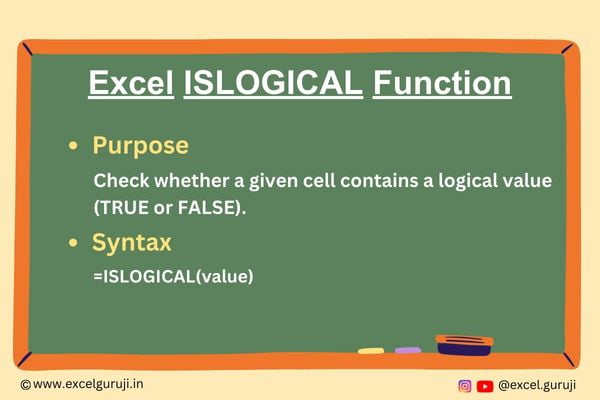
When to Use the Excel ISLOGICAL Function in Excel
The ISLOGICAL function in Excel comes in handy when you need to determine whether a given cell contains a logical value. Logical values in Excel are either TRUE or FALSE and are commonly used in conditional statements and logical operations.
The ISLOGICAL function helps you verify the type of data in a cell, ensuring it aligns with your expectations and requirements.
What Excel ISLOGICAL Function Returns
The Excel ISLOGICAL function returns TRUE if the provided value is a logical value (TRUE or FALSE) and FALSE if it is any other data type.
Syntax of Excel ISLOGICAL Function
The syntax of the Excel ISLOGICAL function is as follows:
=ISLOGICAL(value)
Input Arguments
Here is the input argument for the Excel ISLOGICAL function:
● value: The value argument can be a cell reference containing the data or a direct entry of a logical value, a formula that evaluates to a logical value, or any other data type.
Examples of the Excel ISLOGICAL Function
Here are few examples demonstrating the usage of the ISLOGICAL function in Excel:
Example 1: Basic Usage
Suppose you have data in column A, and you want to check whether it is a logical value or not. Enter the following formulas in column B:
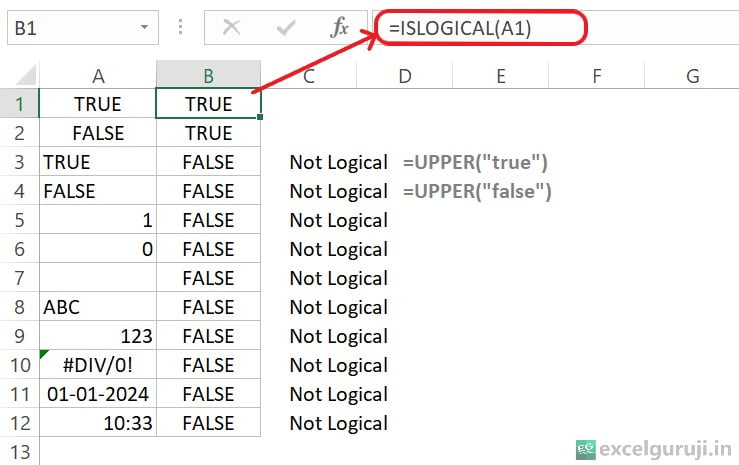
It returns TRUE if the given value is a logical value and FALSE if it is any other data type.
Example 2: Count Logical Value Cells
The formula =SUMPRODUCT(–ISLOGICAL(A2:A13)) in Excel is used to count the number of cells within the range A2:A13 that contain logical values.
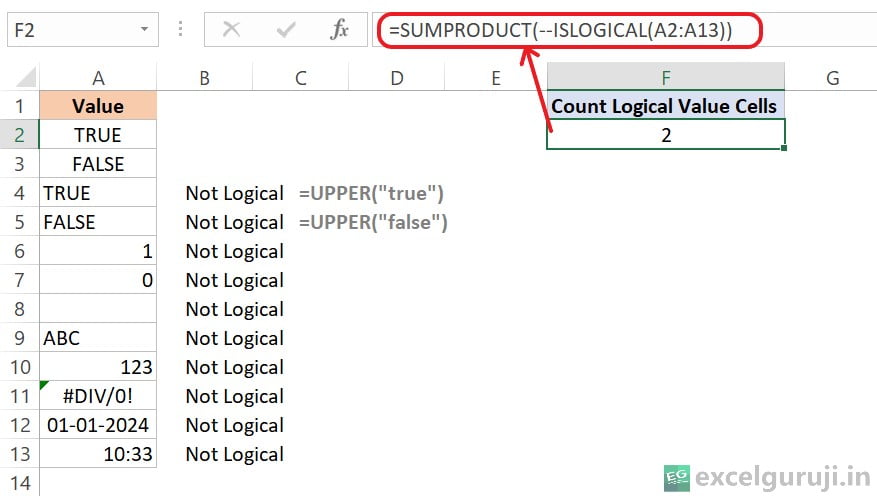
Let’s break down the formula:
- ISNUMBER(A2:A13): This part of the formula checks each cell in the range A2:A13 and returns an array of TRUE for cells containing logical values and FALSE for cells with non-logical values.

- — (double unary operator): This is a conversion operation that turns TRUE into 1 and FALSE into 0. It coerces the TRUE/FALSE array into an array of 1s and 0s.

- SUMPRODUCT: This function then adds up the values in the resulting array. In this context, it effectively counts the number of cells in the specified range that contain logical values.
So, the overall purpose of the formula is to provide a count of how many cells in the range A2:A13 contain logical values.
Example 4: Applying ISLOGICAL in Data Validation
Suppose you wish to restrict cells A1 to A10 to accept only logical values, preventing the entry of any non-logical values. In such cases, you can utilize the ISLOGICAL function in data validation, as demonstrated below:
- Select the range A1:A10.
- Go to the Data tab and click on Data Validation.
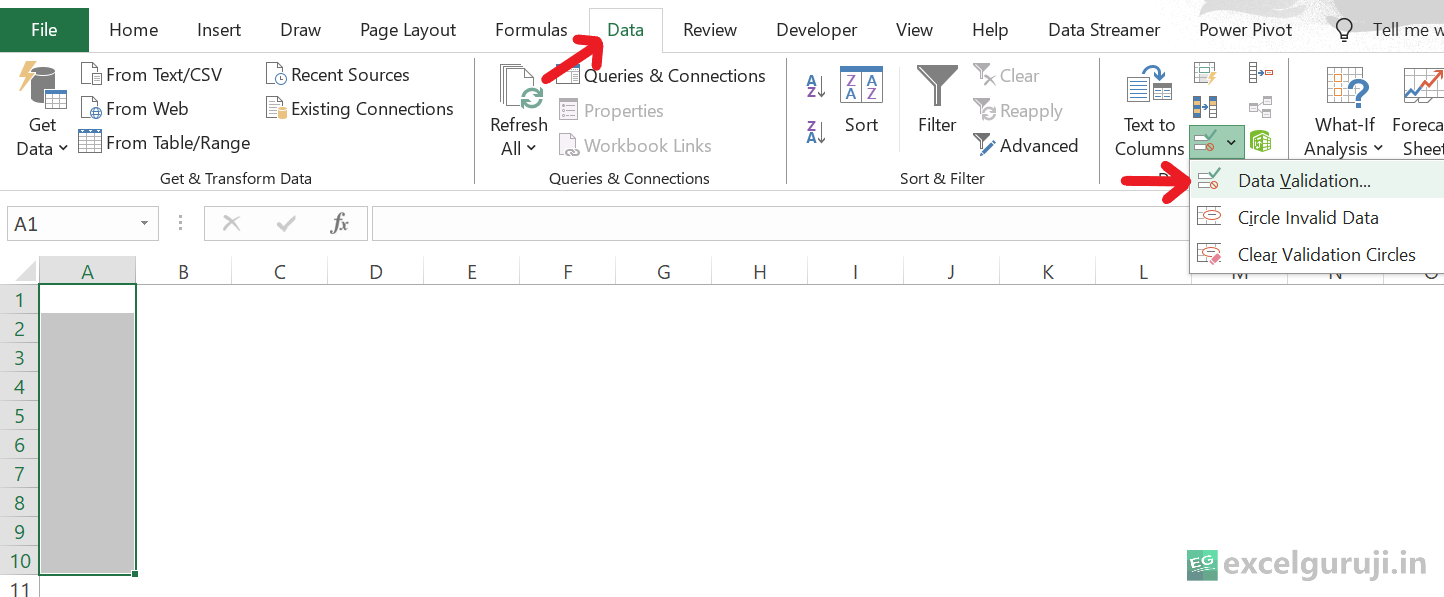
- Choose Custom as the validation criteria.
- Enter the formula: =ISLOGICAL(A1)
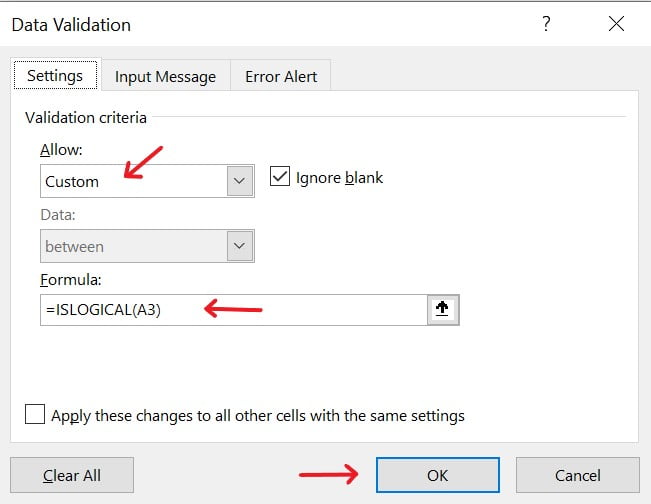
- Now, only cells containing logical values will be accepted in the selected range. As depicted in the image below, logical value inputs are accepted in cells A1 and A2; however, when attempting to input a number in cell A3, a restriction message is displayed.
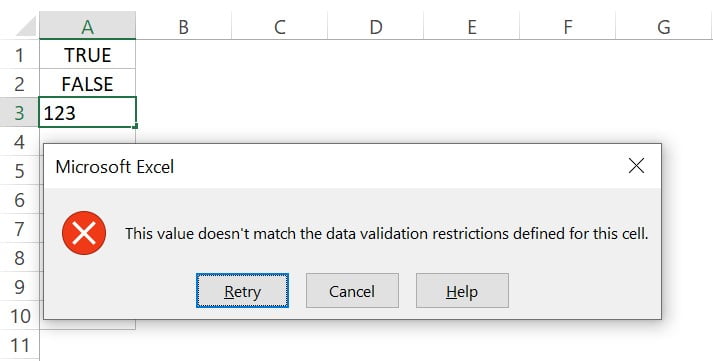
Practice Workbook
Download Free Excel File For PracticeConclusion
In conclusion, the Excel ISLOGICAL function is a valuable tool for checking the type of data present in a cell. Whether you are working on data validation, conditional formatting, or logical operations, the ISLOGICAL function can help ensure the integrity of your data.
Remember to incorporate ISLOGICAL into your Excel arsenal to enhance your data analysis and decision-making processes. As with any Excel function, practice and experimentation will deepen your understanding and proficiency. Start utilizing the ISLOGICAL function today and streamline your Excel workflow!
Frequently Asked Questions (FAQs)
Q1: Can the ISLOGICAL function be used to check for non-logical values?
A1: Yes, the ISLOGICAL function returns FALSE if the provided value is not a logical value.
Q2: What does ISLOGICAL return if the cell is empty?
A2: If the cell is empty, ISLOGICAL returns FALSE.
Q3: Can ISLOGICAL be combined with other functions for more complex checks?
A3: Yes, combining ISLOGICAL with other functions allows you to create intricate logical checks in your Excel formulas.
Q4: Are there any specific scenarios where ISLOGICAL is particularly useful?
A4: ISLOGICAL is particularly useful in scenarios where you need to validate data before performing logical operations or making decisions based on the type of data present in a cell.
Other Related Excel Functions
Mastering Excel ISBLANK Function: A Comprehensive Guide for Efficient Data Analysis
Excel ISERROR Function: A Guide to Mastering Error Detection
Mastering Error Detection: A Guide to Excel ISERROR Function
Join me on Instagram, YouTube and WhatApp Channel for your daily dose of valuable tips and tricks! Catch insightful videos that will enhance your knowledge and skills. Don’t miss out – follow me now!